
|
Gas Giant Clouds: Their Origin and Structure by Brian Vanderwende |
||||||
Outline
Introduction - Planetary Atmospheres The study of clouds is one that is filled with uncertainty. Cloud processes and feedbacks play a large role in the energy balance of Earth’s climate system. Some clouds efficiently block out solar radiation, cooling Earth, while others efficiently absorb outgoing infrared radiation, warming the climate. The extent to which clouds do these things globally, as well as how the process is changing, is largely still a mystery. With our understanding of clouds on Earth still in its early stages, it should come as no surprise that we know even less about extraterrestrial clouds. We know that the clouds on the other terrestrial planets are driven by similar mechanisms – mainly solar heating – and have many of the same effects as they do on Earth. The clouds on the gas giant planets are harder to describe however. Since we do not live on a gas planet, we do not have a good analog for their atmospheres. The only ways in which we can study them are remotely though telescopes and satellites and directly through short-lifetime probes. The gas giant planets in our solar system – Jupiter, Saturn, Uranus, and Neptune, are very different from the rocky planets of the inner solar system. They are large and massive, containing approximately 99.5% of the non-solar mass in the solar system. They contain vast amounts of gasses, liquids and ices of various compositions. The atmospheres (and liquid beneath) of these planets dominate the mass of the planet, which is opposite the situation for the terrestrial planets. But they were not always so different. Early in the evolution of the solar system, when an accretion disk of stellar material orbited the early proto-Sun, all of the planets were likely small rocky masses. Every planet likely accumulated hydrogen and helium in their early primary atmosphere. These are the materials that make up the gas giants today, but they are largely absent in the atmospheres of the rocky planets. The evolution of the planets likely diverged when the Sun started emitting particles and radiation – the solar wind – about ten million years after the coalescence of the proto-planets and Sun. When this began, the inner planets’ primary atmospheres were lost as they were blasted off by the new “wind.” The outer planets however, had two advantages. They were more massive – likely about ten to fifteen times as large as the inner planets, and they are also further away from the Sun. Thus, the atmospheres of the planets that we observe today have very different origins. The inner planets have secondary atmospheres which were formed from outgassing of material from inside them. The gas giants, meanwhile, still retain their massive primary atmospheres. Even though the gas giants’ atmospheres are huge compared to those of the terrestrial planets, they are still relatively thin compared to the liquid ocean layers beneath. The boundary between gas and liquid is likely not detectable, as the highly compressed gas right above the liquid layer would seem indistinguishable from the liquid itself. The composition of these gaseous and liquid layers on the outer planets varies among the four. Jupiter and Saturn are true gas giants, comprised mainly of hydrogen and helium. Jupiter is especially hydrogen rich – having a similar composition to that of the Sun (ten hydrogen atoms for every one helium). On both Jupiter and Saturn, vast metallic hydrogen and helium oceans exist below the atmosphere. Similar oceans are likely present on Uranus and Neptune, but with very different materials. On these planets, heavy elements dominate the mass balance. Oceans of water, ammonia, methane and other low density ices probably make up these sub-atmospheric layers. Thus, Uranus and Neptune are better described as ice giants, as they contain much less hydrogen and helium gas than Jupiter and Saturn. Clouds on the Gas Giants With such varied atmospheres between the different outer planets, one might expect to see varied cloud formations. This is exactly what has been observed. Once again, there is a large difference between what has been observed on the gas giants and on the ice giants. Jupiter and Saturn exhibit cloud tops that are relatively easy to identify and cover most of the surface of the planet. Uranus, on the other hand, is largely cloud free. Neptune is also quite devoid of cloud features, with only a few high clouds visible on top of a deep clear atmosphere. The clouds themselves exist in layers which are present on each of the planets. Unlike Earth, where almost all of the cloud features are caused by water vapor, a collection of different condensable materials (called volatiles) make up the different cloud layers on the outer planets. These layers of clouds are made possible by the enormous mass of the planets – at increasing depths in the atmosphere larger and larger pressures and higher temperatures are present. Thus, as you travel (hypothetically) downward through the atmosphere of each gas planet, different cloud layers represent the point at which the temperature and pressure is appropriate for condensing that particular volatile. The clouds also signify the border between volatile regimes. Below the condensation layer for a volatile, it will be well mixed as a gas. Above the clouds, the volatile is highly depleted. The presence of different cloud layers depends on the composition and thermal characteristics of each planet. For example, the highest clouds on Uranus and Neptune are composed of crystals of methane ice. These clouds are not observed on Jupiter and Saturn because they are too warm – a consequence of their lesser distance from the Sun and also their more intense internal heat generation.
The clouds are generated by a couple different mechanisms which have already been mentioned earlier in this article. In a similar situation to that on Earth, incoming solar radiation inputs energy into the atmospheric systems of the gas giants; this then causes air to move and clouds to form. A quick energy balance calculation shows, however, that this energy source is not sufficient to explain observed atmospheric temperatures of the gas planets. Thus, unlike on Earth, internal energy plays a large role in the generation of atmospheric motion and clouds. This internal energy is created as gravitation potential energy is converted into kinetic energy deep within the planets. Observations of Jupiter, Saturn and Neptune show that they are all emitting about twice as much energy as they are receiving from the Sun. This is not so on Uranus, which likely indicates weaker internal energy generation. Regardless of the source of the energy, the added heat causes convection to initiate in the atmospheres. The convective motion then gains strong spin due to the large Coriolis Effect present on these enormous (and in some cases rapidly spinning) planets. These convectively driven vorticies likely drive the large cloud bands which are observed on the gas giants Jupiter and Saturn. Rising air is present in the center of the cyclonic vorticies, which allows the air to cool as it expands in the same way that rising air cools in storm systems on Earth. As the air cools, volatiles can grow through condensation, and then eventually cause rain (which would obviously evaporate before ever hitting a surface as often happens on Earth). This rain interacts with air molecules as it falls, and in certain situations – especially in the case of water – can generate charge distributions. This means that clouds on the gas giant planets are capable of generating lightning. This was first observed directly by the Voyager space probe, which visually confirmed the presence of lightning on Jupiter and detected lightning strikes on other planets though interference in radio signals. Observation and Modeling of the Clouds Even though we have the conceptual models described above to explain the known presence of clouds on the gas giants, the models do not necessarily agree with observations. The clouds on Jupiter and Saturn, in particular, are hard to explain. An analysis performed by Atreya et al. of information both from remote measurement and from the Galileo probe, which descended into the Jovian atmosphere and directly collected meteorological information, indicate depleted levels of the condensable volatiles which are required for cloud formation. This could be explained by the locations at which the measurements were taken. The location of the band on the electromagnetic spectrum used for remote measurements on volatile concentration was chosen because it allows us to see fairly deep into the Jovian atmosphere. Unfortunately, this spectral band tends to over represent “hot spots” on Jupiter – areas where the atmosphere is optically thin and so large amounts of heat are allowed to radiate to space. Similar regions may be over represented on Saturn. The problem arises because these regions are dry, and they by their very nature are areas with low concentrations of volatiles. The Galileo probe measurements likely have the same issue, as the instrument descended through one of these hot spot regions. Various dynamical solutions have been proposed to explain why these regions are dry and lack volatiles. Atreya et al. propose that downdrafts with entrainment and mixing are present in these hot spots. Unfortunately, this solution has a major inconsistency with observation; the probe measured many regions of both upwelling and downwelling – not a single main downdraft. The same research group also performed an analysis of the cloud features using computer modeling. They used the Equilibrium Cloud Condensation Model (ECCM) to simulate the atmospheres of Jupiter and Saturn. The model itself is somewhat simplistic. It does not contain any microphysics and thus any clouds that form cannot precipitate. The authors state, however, that it is the best model currently available for simulating the atmospheres of the outer planets. The model overpredicts cloud concentrations as a result of these inadequacies, but it seems to do a good job representing the lifting condensation level of each volatile. According to the model, water clouds are predicted to be both the deepest and the thickest of the different layers, with ammonium hydrosulfide and ammonia cloud layers above the water clouds. The following figures show the results of the model.
Analysis of the Planets Jupiter
The clouds on Jupiter are the most vibrant and easily recognizable in the entire solar system. The planet has twelve or more parallel bands of cloud features ranging in color from bluish gray to various shades of red, orange and pink. The dark bands are referred to as belts and the light regions are called zones. These areas arise from overturning circulations. The belts tend to be areas of downwelling motion while the zones are areas of upwelling air. The coloration of the clouds on any gas giant, but especially evident on Jupiter, likely comes from impurities in the clouds. The suspected materials creating these impurities include elemental sulfur and phosphorus as well as various organics that are produced by photochemical reactions that result from the interaction of solar ultraviolet and Jovian hydrocarbons. In the zones, rising air causes ammonia to condense and form clouds over top of these darker impure cloud layers. This is why the zones appear much brighter than the belts. These ammonia clouds on Jupiter appear near the top of the troposphere at a temperature of around -140°C. Zuchowski et al. modeled the overturning circulation in the Jovian troposphere, which produced some interesting results. Their model showed temporary reversals of the downwelling in the belts. This supports observed high water clouds and lightning in these regions. Storm systems can and do form inside of the belts as well as along their edges. The biggest and most famous example of this is the Great Red Spot, a giant oval anticyclonic storm. It has a length of about 25,000km and a width of about 12,000km – big enough to fit multiple Earths inside. This storm also exhibits behavior which has been termed cloud cannibalism. Often, when smaller storm systems approach the Great Red Spot, they are devoured by the large storm and become a part of it. In addition to these storms, Arregi et al. found repeating trains of cloud bands during some time periods in the equatorial region, which likely indicate the presence of gravity waves in the Jovian atmosphere. These gravity waves were observed to have phase speeds ranging anywhere from 0 to 40m/s. Evidence of these waves is present in data collected by Voyager 1 and 2, Galileo and by the New Horizons mission to Pluto as it encountered Jupiter during its travel. Curiously, they were not observed by the Cassini spacecraft as it flew by Jupiter. The reason for this discrepancy is likely due to changes in either the unstable atmospheric region which causes the waves to form, or the stable layer in which they exist and propagate. Saturn
Saturn’s atmosphere is banded with clouds much like Jupiter, but these bands are visually much more subdued. Individual cloud systems are thus rarely observable from Earth. An interesting feature, which has been observed from our planet, is that on infrequent occasions large cloud features erupt in the tropics. These cloud systems then spread longitudinally and then proceed to fade away over the course of a few months. The reason for this phenomenon is largely still a mystery. When Saturn is seen from closer up, with probes such as Voyager and Cassini, narrow and meandering bands of clouds which encircle the planet have been observed in the mid northern latitudes. These features appear similar to Earth’s jet streams, but Saturn has jets of its own. These wind maxima have been observed in both hemispheres in regions away from the equatorial zone. Garcia-Melendo et al. studied these jets and found that vertical shear in cloud regions in and around the jets are approximately 10-20 m/s between the pressure levels of 100mb and 350mb. It is interesting to note that while jet streams tend to be the regions of highest winds on Earth, the winds of the jets on Saturn pale in comparison to the equatorial winds, which are the strongest observed in our solar system. Saturn also has storm systems with cyclonic and anticyclonic winds. A large system similar in appearance to the Great Red Spot was observed for a time on Saturn, but has since disappeared.
Uranus

Like Uranus, relatively little is known about the atmosphere of Neptune. Also like Uranus, Neptune’s atmosphere has a mass equivalent to a few Earth masses. It also has more water and ices than Jupiter and Saturn. The planet exhibits seasons which are similar to those of both Saturn and Earth, although the strength of the seasons obviously differs amongst the three due to their various distances from the Sun. When the Voyager probe passed by Neptune, it observed some small clouds which cast shadows down onto a dense cloud layer approximately 75km below. Beyond these features, the surface appears dark blue, once again due to molecular scattering of radiation. Some weather has been observed on Neptune. A Great Dark Spot, similar to Jupiter’s Great Red Spot, was observed, but has since disappeared. Other Gas GiantsIt is likely that some of the characteristics present in the gas and ice giants of our solar system extend to those present elsewhere in the Universe. It is just as likely that they vary in ways previously unknown. As technology, and thus our ability to view the cosmos, improves, we will learn more about these other planets and in the process learn more about our own nearby giant neighbors. References Arregi, J., J.F. Rojas, R. Hueso, and A. Sánchez-Lavega, 2009: Gravity waves in Jupiter's equatorial clouds observed by the Galileo orbiter. Icarus, 202, 358-360. Atreya, S.K., M.H. Wong, T.C. Owen, P.R. Mahaffy, H.B. Niemann, I. de Pater, P. Drossart, Th Encrenaz: 1999: A comparison of the atmospheres of Jupiter and Saturn: deep atmospheric composition, cloud structure, vertical mixing, and origin. Planet. and Space Sci., 47, 1243-1262. Garcia-Melendo, E., A. Sánchez-Lavega, J.F. Rojas, S. Pérez-Hoyos, and R. Hueso, 2009: Vertical shears in Saturn's eastward jets at cloud level. Icarus, 201, 818-820. Hester, J., D. Burstein, G. Blumenthal, R. Greeley, B. Smith, H. Voss, G. Wegner, 2002: 21st Century Astronomy. W. W. Norton & Company, 545 pp. Zuchowski, L.C., Y.H. Yamazaki, and P.L. Read, 2008: Modeling Jupiter's cloud bands and decks: 1. Jet scale meridional circulations. Icarus, 200, 548-562. |
||||||
|
This website designed and maintained by Brian Vanderwende. 2009. |

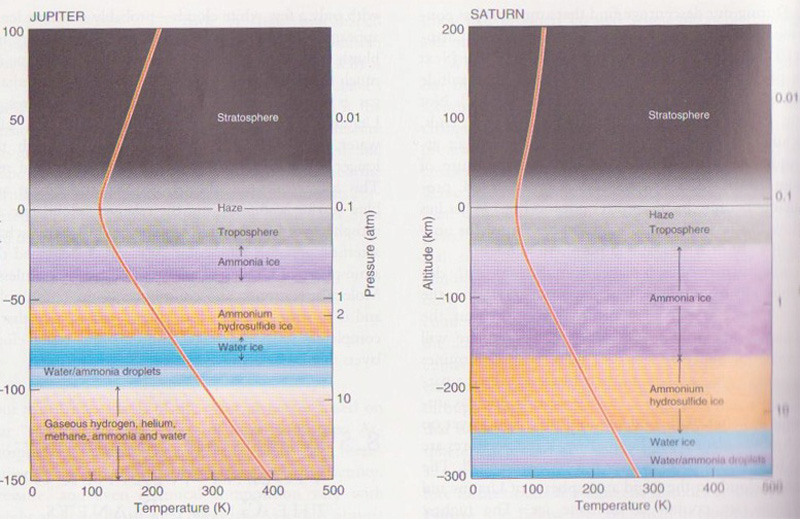
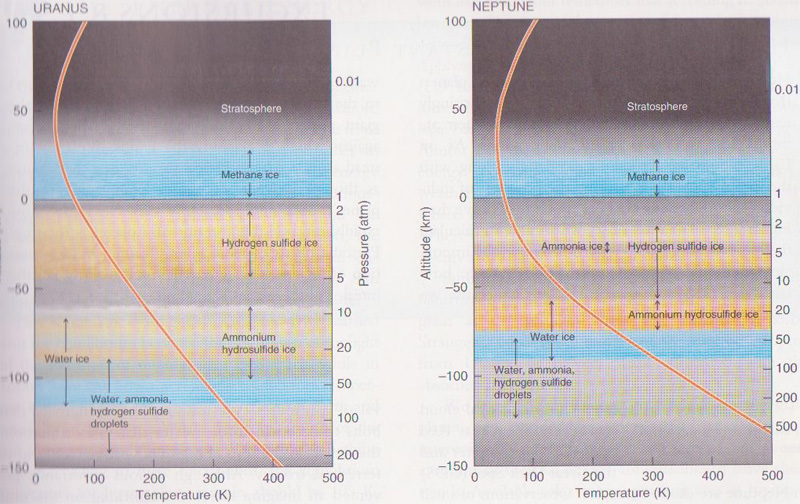
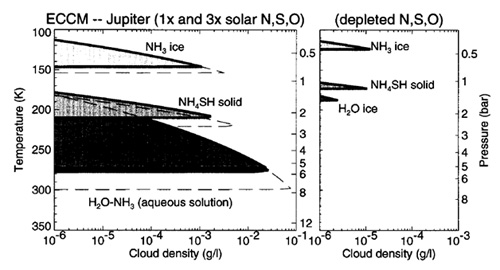

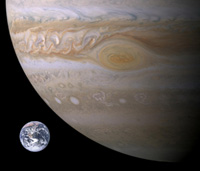 Jupiter is, of course, the largest of all the planets in our solar system. It has an atmosphere that is roughly three hundred times the mass of Earth. As mentioned before, its atmosphere contains mainly hydrogen with some helium as well. Most of the heavier elements, such as iron and even water likely ended up in Jupiter’s solid/liquid core. The weather present on Jupiter has low seasonal variability. In fact, Jupiter has almost no seasons at all due to its low obliquity of only three degrees.
Jupiter is, of course, the largest of all the planets in our solar system. It has an atmosphere that is roughly three hundred times the mass of Earth. As mentioned before, its atmosphere contains mainly hydrogen with some helium as well. Most of the heavier elements, such as iron and even water likely ended up in Jupiter’s solid/liquid core. The weather present on Jupiter has low seasonal variability. In fact, Jupiter has almost no seasons at all due to its low obliquity of only three degrees.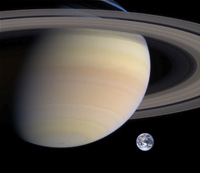 Saturn might be the most instantly recognizable of all of the planets with its distinctive and remarkable rings. The planet itself is not much smaller than Jupiter, but differs in composition. Saturn’s atmosphere is roughly one hundred times the mass of Earth – about one-third the mass of Jupiter’s. For it to be similar in size to Jupiter, it must have a much lower density, which is exactly what has been observed. In fact, Saturn on average has a density which is only seventy percent that of water, meaning if you could place Saturn in a body of water large enough, it would float.
Saturn might be the most instantly recognizable of all of the planets with its distinctive and remarkable rings. The planet itself is not much smaller than Jupiter, but differs in composition. Saturn’s atmosphere is roughly one hundred times the mass of Earth – about one-third the mass of Jupiter’s. For it to be similar in size to Jupiter, it must have a much lower density, which is exactly what has been observed. In fact, Saturn on average has a density which is only seventy percent that of water, meaning if you could place Saturn in a body of water large enough, it would float.
 Uranus is much smaller than Jupiter or Saturn in both volume and mass. It has an atmosphere which has the mass equivalent of a couple times the Earth. It contains more water and ices than the gas giants. The planet has peculiar seasonal variation due to its unique orientation. Uranus spins facing the Sun, so each pole experiences extreme seasons in which it will see 42 years of sunlight and then the same amount of night. The surface of Uranus is largely devoid of features. Clouds are rarely observed. What is seen is a thick atmosphere. Much as Rayleigh scattering causes the sky on Earth to appear blue, it also is the reason for Uranus’ blue color. All we can observe on the planet is its thick layer of air. Models predict that below this upper atmosphere thick ammonia and water ice cloud layers lie below, but these simulations cannot be corroborated by observation. Despite the bland appearance of the surface in the visible, near-infrared observations found small clouds and a weak cloud band near the planet’s southern pole. These, however, are the only cloud features which have been directly observed.
Uranus is much smaller than Jupiter or Saturn in both volume and mass. It has an atmosphere which has the mass equivalent of a couple times the Earth. It contains more water and ices than the gas giants. The planet has peculiar seasonal variation due to its unique orientation. Uranus spins facing the Sun, so each pole experiences extreme seasons in which it will see 42 years of sunlight and then the same amount of night. The surface of Uranus is largely devoid of features. Clouds are rarely observed. What is seen is a thick atmosphere. Much as Rayleigh scattering causes the sky on Earth to appear blue, it also is the reason for Uranus’ blue color. All we can observe on the planet is its thick layer of air. Models predict that below this upper atmosphere thick ammonia and water ice cloud layers lie below, but these simulations cannot be corroborated by observation. Despite the bland appearance of the surface in the visible, near-infrared observations found small clouds and a weak cloud band near the planet’s southern pole. These, however, are the only cloud features which have been directly observed.